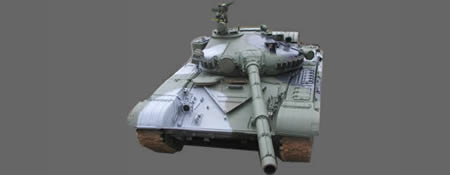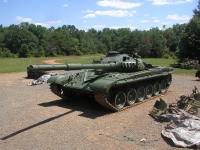|
Get
to know your VMMV staff & vehicles
In
this section we introduce you to the people and armor of the
Virginia Museum of Military Vehicles. We will chat with the
VMMV staff, so that you can get to know the people who "keep
'em running" and work so hard behind the scenes. And also
provide a behind-the-scenes look into the history of individual
vehicles in the VMMV collection. In this, our nineteenth newsletter,
we highlight VMMV's renovation of one of its star attractions,
its T-72 tank.
What
has 780 horsepower, can shoot armor piercing rounds several
kilometers, speaks several languages and weighs 44 tons? VMMV's
T-72 tank! And last summer the decision was made to completely
renovate the vehicle.
Our
T-72 is actually East German in origin, but was built with a
variety of Czech, German and Russian parts. Although the manuals
are in german, many of the assemblies on the interior are marked
in Cyrillic; imagine the difficulty in battle of having to mentally
translate multiple languages.
Before
any paint work was done, VMMV staff and volunteers tested major
circuits on the T-72 and conducted a thorough maintenance and
safety inspection. Several small problems were fixed, starting
with the commander's hatch on top and we worked our way down.
VMMV staff also figured out the intricacies of the T-72's legendary
autoloader…a mechanical device that automatically loads
ammunition into the vehicle's 125mm cannon.
Her
fuel, oil, and coolant systems were overhauled, flushed, cleaned
or topped off with fluid as necessary where we ended up flat
on our back under the belly of the beast. After this preventive
maintenance, it was time to start the engine. We were rewarded
by the deep throaty rumble of a turbocharged V-12 diesel putting
out 780 horsepower at full song.
Any
tank needs grease….lots and lots and lots of grease. Whether
to allow the turret to turn effortlessly, or the roadwheels
to spin with minimal heat buildup, you can't overgrease a tank.
So VMMV staff brought out a big bucket of grease, an air line
and set about lubing and greasing any fitting they could find.
We think the tank probably settled an inch or two with all the
grease we used!!!! All this was done before final paint to avoid
chipping the new paint.
VMMV
then attacked the paint renovation task with their usual enthusiasm.
Anything detachable was removed and cataloged to allow preservation
work on the tank's exterior. First, a complete wash-down to
get rid of caked-on dirt. Then we sanded rusty spots down to
bare metal and applied primer. That took lots and lots of elbow
work and sweat equity, but that didn't stop the staff and volunteers.
VMMV
decided to paint the T-72 in camouflage colors, rather than
Soviet base green. Since the vehicle was East German, we researched
various schemes and settled on a combination of dark grey, green
and light grey. As you can see, it took some time to paint the
various layers. And just like any sundae isn't finished until
the whipped cream is on top, VMMV finished off the brand new
paint with genuine East German roundels salvaged during our
initial trip to transport the T-72. Add in the East German flag,
and no one can miss the new Queen of the Open House, VMMV's
newly renovated T-72.
CLICK
TO ENLARGE
As
part of the T-72's renovation process, we pulled the complete
drivers seat assembly from its position to allow us to clean
that area of dirt and debris. Imagine our surprise when we discovered
a Cold War relic….a Soviet lapel badge. Our research indicates
this badge was awarded only to Soviet officers during the 1960s
to 1980s, and is a "Combined Arms Specialist, 2nd Class"
lapel pin. It is interesting to think what Soviet officer was
visiting this East German T-72, crawling around the drivers
position and upon exiting, had his lapel badge ripped off, to
await discovery by VMMV staff decades later.
|

















